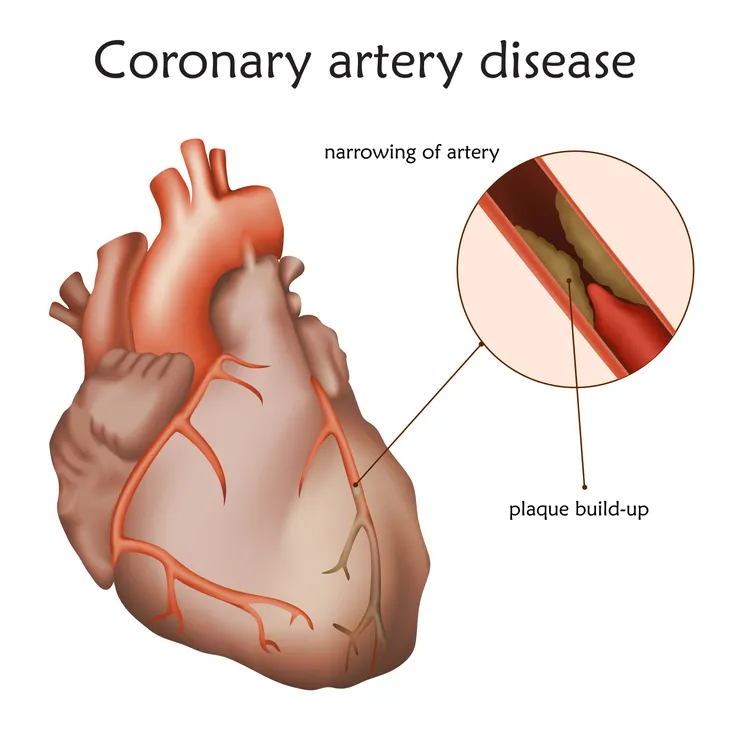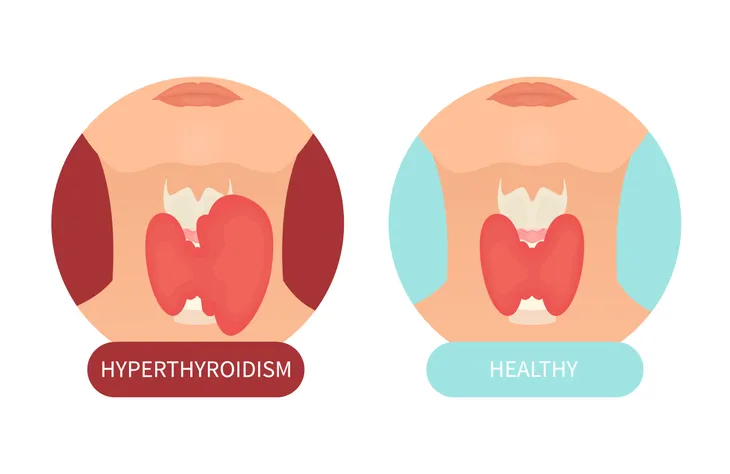Atrial fibrillation, or Afib, is the most common abnormal heartbeat, or arrhythmia. The upper chambers, or atria, of the heart beat very rapidly and out of sync, which results in the quivering, or fibrillation, of the heart walls. The precise mechanisms contributing to atrial fibrillation are not completely understood, but it has strong associations with other cardiovascular diseases.
Atrial fibrillation can be categorized as paroxysmal (lasting less than 7-days), persistent (lasting more than 7-days), or permanent (persisting for more than 1-year). The majority of episodes resolve in less than 24-hours. Twelve causes of atrial fibrillation include…
1. Coronary Artery Disease
Coronary artery disease (CAD) refers to the narrowing or blockage of arteries in the heart. It is the most common cause of death among men and women in the United States. The most common cause of CAD is atherosclerosis, which is the deposition of cholesterol and fat in the inner walls of arteries. It robs the heart muscle of its blood supply causing oxygen starvation, which leads to chest pain, or angina, and ultimately a heart attack.
Coronary artery disease’s contribution to the development of atrial fibrillation is thought to be oxygen starvation, or ischemia, of the atria (upper chambers of the heart). As a result, a key strategy in the treatment of atrial fibrillation is the administration of a class of drugs called the calcium channel blockers. These drugs cause arteries to relax and widen, which increases oxygen delivery to oxygen starved heart muscle cells.
2. Hypertension
Hypertension, or high blood pressure, means the blood pressure in an individual’s arteries are above the normal range. Blood pressure measures the force of blood pushing against arterial walls. In most cases, the cause of hypertension is unknown. Blood pressure is expressed as two numbers such as 110/80. The top number represents the systolic blood pressure (when the heart contracts), while the bottom number represents the diastolic blood pressure (when the heart relaxes).
Hypertension’s contribution to the development of atrial fibrillation is atrial remodeling and enlargement, which is induced by abnormally high blood pressures. A normal blood pressure is 120/80. The diagnosis of hypertension takes into account not only blood pressure, but age. In individuals younger than 60-years, hypertension is defined as a blood pressure greater than 140/90. In individuals older than 60-years, hypertension is defined as a blood pressure greater than 150/90.
3. Congenital Heart Defects
Congenital heart defects refer to structural issues arising from abnormal formation of the heart or major blood vessels. The term “congenital” refers to a condition present at birth. At least 35 types of congenital heart defects have been described. In some cases of congenital heart defects, heredity or genetic disorders such as Down syndrome may play a role. In most cases, no obvious cause is identified. Most congenital heart defects have to be surgically corrected.
The role of congenital heart defects in the development of atrial fibrillation is thought to center around left atrial remodeling and enlargement, which is induced by abnormally high blood pressures. Adults who have a history of congenital heart defects with current atrial fibrillation present treatment dilemmas, because they don’t respond to all of the traditional treatments for atrial fibrillation. Furthermore, preventing reoccurrences of atrial fibrillation is particularly difficult in individuals previously diagnosed with congenital heart defects.
4. Rheumatic Heart Disease
Rheumatic heart disease is a complication of rheumatic fever. Rheumatic fever is an inflammatory disease that develops as a result of untreated strep throat. Strep throat is an infectious disease caused by streptococcal bacteria. It is a common cause of sore throat in children and adolescents. Prompt diagnosis and treatment of strep throat with antibiotics is imperative to prevent complications such as rheumatic fever and rheumatic heart disease.
Rheumatic heart disease’s role in the development of atrial fibrillation is mediated by chronic inflammation caused by rheumatic fever. Rheumatic fever is rare in the United States, but remains common in developing countries. Rheumatic heart disease represents permanent damage to the heart caused by rheumatic fever. The most common area for heart damage is the mitral valve, which is between the two left chambers of the heart. The damaged mitral valve increases the risk of developing atrial fibrillation.
5. Pericarditis
Pericarditis is inflammation of the pericardium, or the thin membrane surrounding the heart. The disease can be acute (short duration) or chronic (long duration). There are many causes of pericarditis. Most cases of pericarditis are due to viral infection, but it can also be caused by bacterial, fungal, or parasitic infection. The autoimmune diseases lupus, scleroderma, and rheumatoid arthritis sometimes cause pericarditis. Lastly, heart attack or heart surgery may be complicated by pericarditis.
The role of pericarditis in the development of atrial fibrillation is mediated by chronic inflammation, which ultimately affects the atria of the heart. Chronic inflammation from pericarditis leads to scarring and calcification of the membrane surrounding the heart, which leads to a complication termed constrictive pericarditis. The complication affects the pumping ability of the heart. Constrictive pericarditis also increases the likelihood of developing atrial fibrillation.
6. Hyperthyroidism
Hyperthyroidism is a medical condition characterized by the thyroid gland producing too much thyroid hormone. It is often referred to as an overactive thyroid. The thyroid is a small, butterfly-shaped gland located in the front of the neck and governs an individual’s metabolism. As a result of excess hormone, the thyroid accelerates the metabolism causing symptoms such as weight loss, rapid heartbeat, anxiety, increased appetite, fatigue, heat intolerance, protruding eyeballs, and an enlarged thyroid gland.
Hyperthyroidism contributes to the development of atrial fibrillation as a result of metabolic stress, specifically the increase in heart rate leading to oxygen starvation (ischemia) in the atria. It is the most common cardiac complication of hyperthyroidism. A study published in the British Medical Journal found a close association between increased thyroid activity and the risk of developing atrial fibrillation. In other words, hyperthyroidism (increased thyroid activity) imparts a high risk for the development of atrial fibrillation.
7. Diabetes Mellitus
Diabetes mellitus is a chronic condition resulting in hyperglycemia, or high levels of glucose (sugar) in the blood. There are three major types of diabetes mellitus: type 1, type 2, and gestational (pregnancy induced). The disease results from a deficiency of insulin or the body’s insensitivity to the actions of insulin. Insulin is a hormone (chemical messenger) produced by the pancreas that works to decrease blood glucose levels by promoting the uptake of glucose into the body’s cells.
Researchers theorize diabetes mellitus may contribute to the development of atrial fibrillation by leading to inflammation of the atria (upper chambers of the heart). It seems that diabetes mellitus is an independent risk factor for the development of atrial fibrillation. In other words, it can be a direct cause of atrial fibrillation. A study published in the Journal of the American College of Cardiology concluded women with type 2-diabetes had almost double the risk of developing atrial fibrillation than women without the chronic disease.
8. Obstructive Sleep Apnea
Obstructive sleep apnea (OSA) is a chronic disease that causes an individual to stop breathing while sleeping. The pause in breathing is caused by the intermittent blockage of the airways leading to the lungs. The pause lasts for seconds and may occur hundreds of times while sleeping. Many individuals are unaware that they have OSA. It decreases the quality of sleep and many individuals complain of fatigue and somnolence (sleepiness) during waking hours.
Obstructive sleep apnea’s contribution to the development of atrial fibrillation is thought to be in the form of atrial remodeling and enlargement, which results from abnormally high blood pressures. The disease is an independent risk factor the development of atrial fibrillation, which can make it a direct cause of Afib. The Sleep Heart Health Study carried out by Case Western Reserve University concluded individuals with OSA were four times more likely to develop atrial fibrillation compared to those without OSA.
9. Stimulants
Stimulants are utilized to increase alertness, attention, and energy. Stimulants can be found in a wide variety of items. Caffeine is probably the most well known stimulant and is found in soda, coffee, tea, chocolate, and energy drinks and capsules. Over-the-counter cold, cough, and sinus medications contain pseudoephedrine. Nicotine is obtained from the consumption of tobacco products. Stimulants are the main ingredient in some diet pills. Recreational drugs such as cocaine and methamphetamines are stimulants.
The contribution of stimulants to the development of atrial fibrillation is thought to be an excess of catecholamines, which are hormones produced by the adrenal glands sitting on top of the kidneys. Catecholamines are released in response to stress and increase blood pressure, breathing rate, and heart rate. Concerns are emerging about the increasing popularity of energy drinks, especially among healthy adolescents, and the development of Afib. The association is highlighted in a January 2011 article in the Journal of Medical Case Reports.
10. Chronic Obstructive Pulmonary Disease
Chronic obstructive pulmonary disease, or COPD, is a common lung disease. There are two main forms of COPD—emphysema and chronic bronchitis. The majority of individuals with the disease have a combination of both forms. Smoking is the primary cause of COPD. The disease makes it difficult to breathe and shortness of breath is one of the main symptoms. COPD is a progressive disease, which means it gets worse over time.
The contribution of COPD to the development of atrial fibrillation is thought to be a consequence of atrial remodeling. Smoking, low levels of oxygen, and inflammation all contribute to this phenomenon. COPD is an independent risk factor for the development of atrial fibrillation, which means it can be a direct cause of this arrhythmia. A review article published in the January 2016 edition of Chronic Obstructive Pulmonary Disease: Open Access highlights the association between the two diseases.
11. Pulmonary Embolism
Pulmonary embolism (PE) refers to blood clots in the lungs. It is a potentially fatal complication of deep vein thrombosis (DVT), which is a blood clot, usually originating in the deep veins of the calf area of the leg and travel to lungs. Pulmonary embolism occurs in approximately 60 to 80-percent of individuals diagnosed with DVT. It is the third leading cause of death in hospitalized individuals.
Pulmonary embolism’s contribution to the development of atrial fibrillation is atrial remodeling and enlargement, which is induced by abnormally high blood pressures. A study published in the Journal of Thrombosis and Hemostasis found no causal relationship between atrial fibrillation and PE. The same study also found a strong trend that may suggest an association between PE and Afib.
12. Alcohol Abuse
Alcohol can be an addictive substance. Alcohol abuse represents a pattern of drinking that interferes with an individual’s daily activities of living. It is a very common diagnosis and the United States reports more than 3-million cases per year. Individuals diagnosed with alcohol abuse have a serious drinking problem, but have not yet become dependent on alcohol. Individuals diagnosed with alcohol abuse may at some point become dependent on alcohol.
The contribution of alcohol abuse to the development of atrial fibrillation lies in its role as a metabolic stressor. Conventional wisdom associates heavy drinking with an increased risk of developing atrial fibrillation. A study published in the Journal of the American College of Cardiology concluded even moderate alcohol consumption shares an association with the development of atrial fibrillation. Moderate alcohol consumption can be defined as no more than one drink per day for a woman and no more than two drinks per day for a man.















